|
Printables |
PowerPoints |
Online exercises |
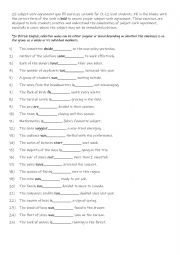
|
25 subject-verb agreement gap fill exercises suitable for C1-C2
25 subject-verb agreement gap fill exercises suitable for C1-C2 level students. Fill in the blanks with the correct form of the verb in bold to ensure proper subject-verb agreement. These exercises are designed to help students practice and understand the complexities of subject-verb agreement, especially in cases where the subject may not be immed...
Level: advanced
Age: 14-100
Type:
Downloads: 117
|
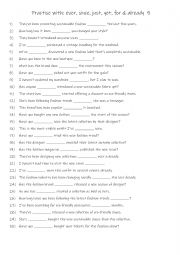
|
A2+-B1 Practise with ever, since, just, yet, for & already 5
First, students need to familiarise themselves with the 6 adverbs and their use. Then they read the sentences to work out which one is needed to complete the gap-fill. Each adverb is used 5 times! Answers on page 2.
Level: elementary
Age: 7-100
Type:
Downloads: 133
|
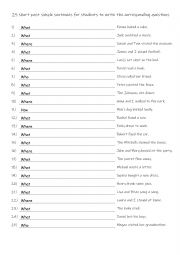
|
A1 25 short past simple sentences for students to write the corresponding questions
Students read the answer and write a suitable question that would lead to the answer, they use the key question word in bold. This worksheet is suitable for A1 level. Answers on page 2
Level: elementary
Age: 9-100
Type:
Downloads: 113
|
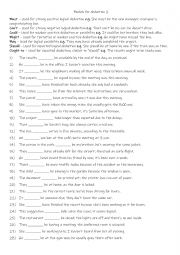
|
A2-B1 7 modals for deduction 2
First, students need to familiarise themselves with the modals and their use. Then they read the sentences to see which one is needed to complete the gap-fill. Each modal is used 4 times! Answers on page 2.
Level: elementary
Age: 9-100
Type:
Downloads: 113
|
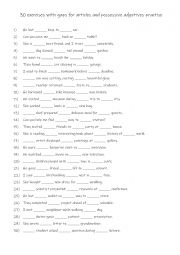
|
Articles and possessive adjectives practise
Students read the sentences and work out what article ( a, an , the) is needed and what possessive adjective is needed according to the subject. Answers on page 2
Level: elementary
Age: 8-100
Type:
Downloads: 107
|
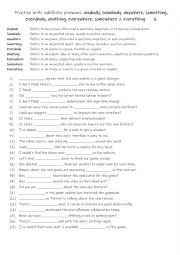
|
A2-B1 Practise with indefinite pronouns anybody, somebody, anywhere, something, everybody, anything, everywhere, somewhere & everything 6
Learning indefinite pronouns like anybody, somebody, anywhere, something, everybody, anything, everywhere, somewhere, and everything is essential for students to express general ideas or refer to non-specific people, places, or things. These pronouns are commonly used in everyday communication to ask questions (e.g., "Is there anybody here?"), make...
Level: elementary
Age: 9-100
Type:
Downloads: 114
|
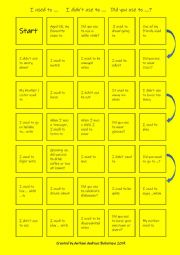
|
Talking about changes in your life
A fun board game with current topics of interest. To encourage lower level students to develop conversational skills by showing interest in what the speaker says also by asking other questions to expand conversation. This sheet should take higher level students around an hour to complete!
Suitable for both pairwork and small groups.
Level: intermediate
Age: 12-100
Type: worksheet
Downloads: 134
|
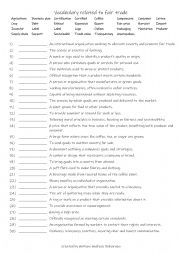
|
B1-B2 Vocabulary related to fair trade
First, students need to familiarise themselves with the 25 words and their meanings Then they read the definitions to see which one is being described and write that word in the space provided. Answers on page 2.
Level: intermediate
Age: 12-100
Type:
Downloads: 118
|
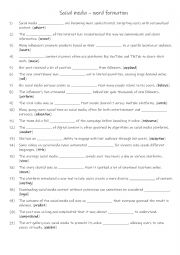
|
B1 Social media word formation
Understanding word formation allows students to expand their vocabulary, enabling them to express themselves more precisely and creatively. Knowing how to manipulate words helps them create varied sentence structures, making their writing more engaging and dynamic. Mastering word formation is key to achieving higher levels of language proficiency, ...
Level: intermediate
Age: 8-100
Type: worksheet
Downloads: 115
|
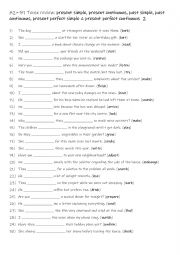
|
A2+-B1 Tense review: present simple, present continuous, past simple, past continuous, present perfect simple & present perfect continuous 2
Students familiarise themselves with the 6 tenses and their use. Then they read the sentences and using the infinitive in () complete the gap-fill with the suitable tense. Answers on page 2.
Level: elementary
Age: 8-100
Type:
Downloads: 104
|
|
|
|
|












